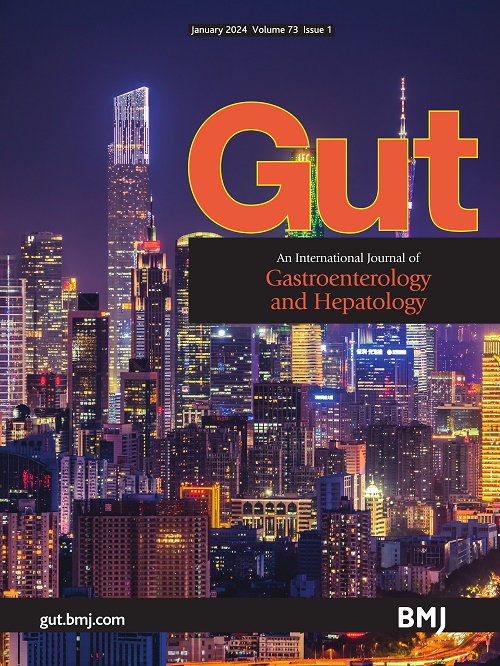Outcome of a FODMAP restriction diet with subsequent blinded reintroduction in functional dyspepsia/postprandial distress syndrome
IF 25.8
1区 医学
Q1 GASTROENTEROLOGY & HEPATOLOGY
引用次数: 0
Abstract
Background Recent studies have shown increased duodenal mucosal permeability as a possible key player in the pathophysiology of functional dyspepsia (FD). Adverse reaction to nutrients is an important candidate underlying mechanism. Intragastric infusion of fermentable oligo-, di-, monosaccharides and polyols (FODMAPs) induced symptoms reminiscent of FD with a rapid onset. Objective We evaluated the effect of a low FODMAP diet (LFD) and individual FODMAP-triggers on symptom severity and duodenal mucosal permeability in FD. Design Patients with FD followed a 6-week LFD and filled out the validated Leuven Postprandial Distress Syndrome (LPDS) daily diary, Short Form-Nepean Dyspepsia Index (SF-NDI) Questionnaire, patient assessment of upper gastrointestinal symptoms (PAGI-SYM) and Patient Health Questionnaire (PHQ). Patients underwent an endoscopy with duodenal biopsies to define mucosal integrity by quantifying transepithelial electrical resistance (TEER) and dextran flux. LFD was followed by a blinded reintroduction during which patients were challenged by 7 powders (fructans, fructose, galacto-oligosaccharides (GOS), lactose, mannitol, sorbitol, glucose). Results 36 FD patients entered the study. LPDS improved significantly at the end of the LFD in 73%. In addition, SF-NDI, PAGI-SYM and PHQ improved significantly. Dextran flux and TEER were not significantly different, but delta TEER correlated positively with delta LPDS. A large variety of FODMAP powders was able to induce recurrence with mannitol as the most prevalent triggering FODMAP (23%). Surprisingly, 27% showed higher LPDS scores during intake of glucose. Conclusions A LFD significantly improved PDS symptoms, but this was not associated with altered mucosal integrity. Powder reintroduction identified a large variety in individual FODMAPs and glucose as triggers. Data are available on reasonable request. On request, all datasets can be provided.FODMAP限制饮食与随后盲法重新引入功能性消化不良/餐后窘迫综合征的结果
最近的研究表明,十二指肠粘膜通透性增加可能是功能性消化不良(FD)病理生理的关键因素。营养不良反应是一个重要的潜在机制。灌胃可发酵寡糖、二糖、单糖和多元醇(FODMAPs)可引起快速发作的FD症状。目的探讨低FODMAP饮食(LFD)和个体FODMAP触发因素对FD症状严重程度和十二指肠粘膜通透性的影响。设计FD患者进行为期6周的LFD随访,并填写经验证的鲁汶餐后窘迫综合征(LFD)每日日记、短表-尼皮恩消化不良指数(SF-NDI)问卷、患者上消化道症状评估(PAGI-SYM)和患者健康问卷(PHQ)。患者接受十二指肠活检内镜检查,通过量化经上皮电阻(TEER)和葡聚糖通量来确定粘膜完整性。LFD之后是盲法重新引入,在此期间,患者被7种粉末(果聚糖、果糖、半乳糖低聚糖(GOS)、乳糖、甘露醇、山梨醇、葡萄糖)挑战。结果36例FD患者进入研究。LFD结束时,lpd显著改善了73%。SF-NDI、PAGI-SYM、PHQ均有明显改善。葡聚糖通量与TEER无显著差异,但TEER与lpd呈正相关。多种FODMAP粉末都能诱发复发,甘露醇是最常见的诱发FODMAP的物质(23%)。令人惊讶的是,27%的人在摄入葡萄糖时显示出更高的LPDS分数。结论:LFD显著改善了PDS症状,但这与粘膜完整性的改变无关。粉末重新引入确定了个体FODMAPs和葡萄糖作为触发因素的大量变化。如有合理要求,可提供资料。如有要求,可提供所有数据集。
本文章由计算机程序翻译,如有差异,请以英文原文为准。
求助全文
约1分钟内获得全文
求助全文
来源期刊

Gut
医学-胃肠肝病学
CiteScore
45.70
自引率
2.40%
发文量
284
审稿时长
1.5 months
期刊介绍:
Gut is a renowned international journal specializing in gastroenterology and hepatology, known for its high-quality clinical research covering the alimentary tract, liver, biliary tree, and pancreas. It offers authoritative and current coverage across all aspects of gastroenterology and hepatology, featuring articles on emerging disease mechanisms and innovative diagnostic and therapeutic approaches authored by leading experts.
As the flagship journal of BMJ's gastroenterology portfolio, Gut is accompanied by two companion journals: Frontline Gastroenterology, focusing on education and practice-oriented papers, and BMJ Open Gastroenterology for open access original research.
 求助内容:
求助内容: 应助结果提醒方式:
应助结果提醒方式:


